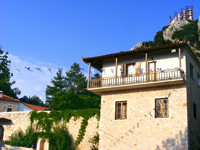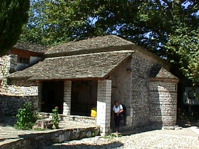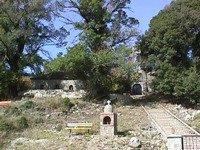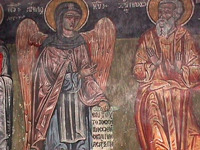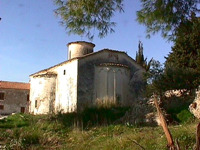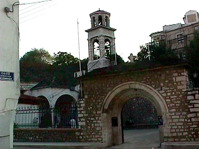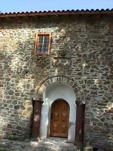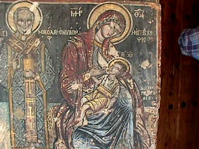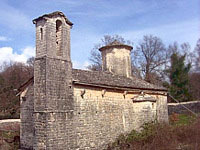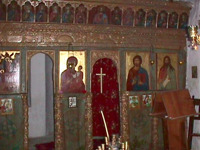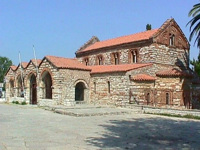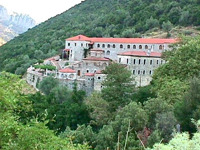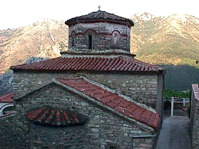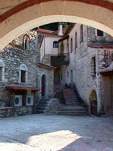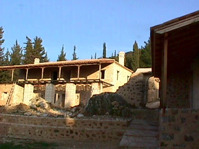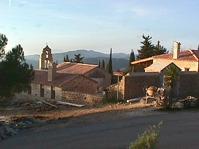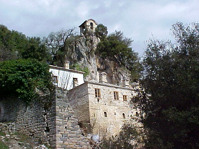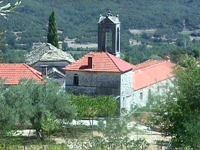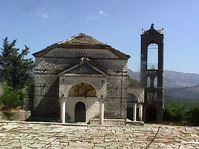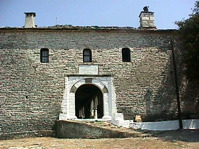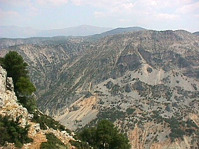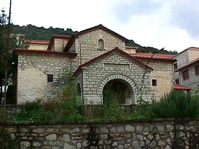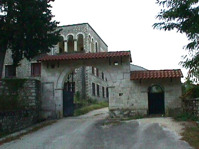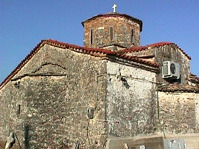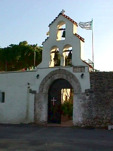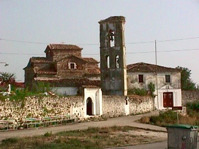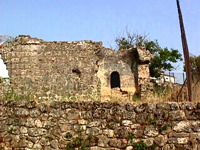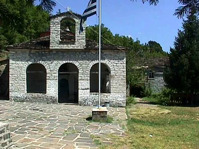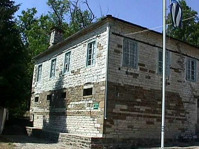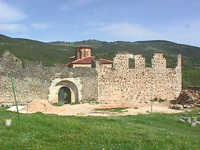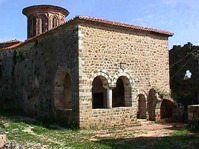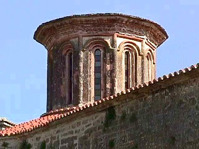epirus net
Αξιοθέατα, δραστηριότητες, ξενοδοχεία,
ξενώνες & ενοικιαζόμενα δωμάτια στην Ήπειρο.
ξενώνες & ενοικιαζόμενα δωμάτια στην Ήπειρο.
Byzantine Monastery of Parigoritissa
The Byzantine Monastery of Parigoritissa is in the centre of the city of Arta. It is about the most important byzanitne monument of Arta, a masterpiece of byzantine art built in basilica archtitecture. It was built between the years 1283 – 1296 and opened as a monastery for the women. The monastery was built on the ruins of an ancient temple by Nikoforos I Komninos the Duke and his wife Anna Palaiologina Kantakouzini.
The architecture of the temple, the wallpaintings, its sculptures, the magnificent dome and generally the inside and outside decoration, are an excellent sample of the age of the Despotate of Epirus. This splendid church is dedicated to the Annunciation. For the history of the church there are many details in various book editions and papers.
From the old monastery for women, have been saved: The church, the Altar, 16 cells and the Dining Hall (dining room) which has been reconstructed and houses findings from the ancient Amvrakia.
The monastery has been characterised preservable and is open to the public as a museum. It belong to the Ephorate VIII of Antiquities.
Museum phone number: +30 26810.28692
Monastery of Virgin Mary of Vella in Vourgareli (Red Church)
The Red Church is at the location of Palaiochori, close to Drosopigi (Vourgareli) of the prefecture of Arta, at a distance of 56 km. from the city of Arta. Its building dates back in the end of the 13th century, when Nikiforos I was the Despot of Arta (there is a sign about it inside the Church). The Red Church λis said that took its name from the colour of the bricks that the outside walls are built. It is also called “Basilomonastery” but also Virgin Mary of Vella, because close to it there was probably an ancient town named Vella or by the fact that it became later a glebe of the Monastery of Vella of Ioannina.
It is an exceptional sample of Church archtitecture of Byzantine art, dedicated to the Birth of Virgin Mary and is maintained in an excellent condition until nowadays. It is a double columned church wirh a cross-shpaed roof and a plastering iconostasis. The outside decoration is similar to this of the church of St. Vasileios which is in the city of Arta. It is lightened by big arched windows.
A sign mentions that the wallpaintings of the main church were painted in 1295 and 1296. Νowadays are saved only a few wallpaintings. In the main part of the church they are maintained in better condition, and there is also saved a very interesting wallpainting which shows Virgin Mary holding Christ surrounded by two couples of the founders of the church, of the couple of Theodoros Tzimiskis and his wife Maria who donated the wallpainting of the church and the couple of Ioannis Tzimiskis and his wife Anna. These portraits especially are considered to be the most ancient ones in Balkans. The byzantine door of the main part of the church is wooden and is still saved.
Monastery of St. George of Riachovo
At the location of Dobritsi of Riachovo, which belongs to the region of Pogoni of the prefecture of Ioannina, is the Monastery of St. George of Riachovo, in a magnificent natural environment.
The monastery was founded and started its building on March in 1998 and was complete on December in 2004, under the supervision and the care of the priest of Riachovo, I. Besios.
The monastery of Riachovo belongs to the Metropolis of Ioannina and in a little time after its opening has shown a significant effort of work.
In the monastery besides the church, there are also available spaces for many kinds of activities, such as: an Amphitheatre for cultural events, entertainment places, basket court, playground, etc.
In the monastery there is also a guesthouse for the hosting of the abandoned elderly persons of the region and it can host 20 persons totally. The guesthouse has 8 double rooms and one triple room.
The region is very interesting for every visitor, as you can enjoy the nature with the beautiful forests of the region, the water from the springs of the region, etc. The region is especially appropriate for school trips.
For more information, Tel.: +30 26510.61315 & +30 6946 148308
Monastery of Paganioi
It is close to the village Kallithea in a dominant position, into a wholegreen region. Its founder was the monk Ioakeim (1652) as it is written on the gate of the church. It is said that the monastery was a glebe of the big cave of Kalavryta. It was a wealthy monastery and a centre during the National Wars. Its history is not famous because its heirlooms and the records were hiiden in 1944 (during the Second World War) by the priest Chis and after were lost.
The architcture of the temple was initially basilica with a dome (that collapsed). The wallpaintings are from different periods, 17th and 19th century, and of excellent technique. The older ones are those of the holy gate (16th – 17th century). The best of them is the icon of the Dormition of Virgin Mary.
The holy gate seems that was preserved by the older existing church during the renovation in 1652. Behind the temple is the cemetery of the bishops Iosif and Amvrosios. It was a monastery for men that was dstroyed in 1944, and it was abandoned until 1962, the year of its renovation. Moreover, recently it was renovated once again. The monastery celebrates on August 15th.
Monastery of St. Nicolas of Flianthropinoi
The monastery of St. Nicolas of Filanthropinoi is at the island of Pamvotis lake. Next to the entrance you can see well-preserved cells and ruins of other buildings. The church is of on space with an arched roof.
It was built by Michael Filanthropinos in the year 1272. It is wallpainted with exceptional mural of 1542 painted with care by Ioasaf Filanthropinos.
In the shape of “Π” around the walls of church there are wallpaintings of 1560. It is distinguished for its value the wallpainting of the 7 wisemen of Greece, which is rare for the orthodox church (during the period when the monastery was open, the ancient greek language was taught in it).
It is also called monastery of Spanos because there taught the Master Spanos. During the period of the despotate of Epirus and after of Ali Passia, it was the most important Religious and Cultural centre.
Monastery of St. Paraskevi of Monodendri
In the famous for its beauty village Monodendri of Zagori, at the cliff of the gorge of Vikos, there is the monastery of St. Paraskevi, which is one of the most ancient monasteries of Epirus.
A beautiful stoned path built in 1412 by Michael, Voevodas of Thereanos, leads us to the entrance of the monastery. It is about a real monastery – fortress: Arched gate, stone buildings, well-built cells, well, trap door, etc. where leads the artistic buliding with stone.
The small church has some old wallpaintings and is also a church of one space with a wooden painted iconostasis. On the left side are painted the founder of the Monastery Voevodas, his wife and his daughter Paraskevi, who acoording to the tradition, passed her whole life in the monastery.
The monastery with its caves by side was a safe shelter for the habitants of the region during the period of revolution against the Turks, Its wild beauty of the around space and the monastery, along with the magnificent Vikos gorge at the region of Monodendri, attracts a lot of tourists every year.
Monastery of Virgin Mary of Kipina
The Monastery of Kipina is close to the village Christoi of Pramanta . According to its history, it owes its name to the gardens close to the monastery that the monks cultivated. According to Serafeim Byzantious the monastery was built in 1212 by someone archbishop named Gregory and is dedicated to the Dormition of Virgin Mary.
It is one the most impressive monasteries of Epirus because it is hanged on a high vertical rock. The paved road reaches to the base of the rock and from that point there is a path on the rock and a wooden bridge that lead to the monastery. During the revolution against the Turks the wooden bridge could be moved. The monks moved it with a lever so as to be protected by invasions.
The small church of the monastery has a lot of wallpaintings probably of the 17th century. The church has the bulk of the rock as roof which creates a perfect dome. Unfortunately many robers took from the monastery many of its holy heirlooms.
At the entrance of the chuch on the left side there is a deep dark cave. During the period of the revolution against the Turks the habitants of the nearby villages were hidden there fro thei safety. The length of the cave is 240 m. and was excavated in 1956 by the speleologist Anna Petrochilou, but it is not approachable.
Monastery of Molyvdoskepasto
Close to the village Molyvdoskepasto of the region of Konitsa, at the borders with Albania and at a distance of 72 km. from Ioannina, there is the walled monastery which is dedicated to the Dormition of Virgin Mary and celebrates on August 15th.
It owes its name, to its roof which in the past had stones of lead. Nowadays the roof of the monastery is made of grey stones.
The hall of the monastery is wallpainted. The woodcarving door is a real masterpiece. There are beautiful wallpaintings, woodcarving pilgrimage hall, arched windows with ceramic decoration. The woodcarving iconostasis is of the 16th century and of excellent technique.
The church has a cross-shaped roof, a high dome and its floor is stoned. The monastery was probably built by the Byzantine Emperor, Constantine Pogonatos.
The sign of the church mentions the year 1521. ΣIn the yard of the church there is the simple grave of Sevastianos, the Despot of Konitsa – Dryinouples.
Monastery of St. Dimitrios in Zalogo
The monastery of St. Dimitrios is under the famous rock of Zalogo with the imposing monument of the dancing women of Souli. It was founded in the middle of the 18th century by the abbot of the Monastery of St. Taxiarches, Dionysious, and from a glebe was turned into a monastery. It is a historical preservable monument.
It was painted by Chistodoulos and Ioannis, wallpainters from Koritiani, in 1816. The monastery λwas conquered and destroyed several times by the Turks, as well as an earthquake destroyed the monastery once again in 1924, but it was renovated.
It was always a monastery for men and not for women. It had a large property and did a lot of charities and donated many works. It had also a lot of glebes.
Nowadays is saved the church (basilica of one space with dome) of the monastery with beautiful wallpaintings inside and outside it, as well as in the cells of the monastery.
Monastery of St. Panteleimon of Ioannina
It is in the island of Pamvotis lake and was founded on the 15th century. It is a historical preservable monument. Inside the monastery was written the end of the life of Ali Passia of Ioannina, who was sieged by the forces of Choursit Passa and under the orders of Sultan, who characterised him as a rebel. So Ali Passia hid here and in the end he was beheaded in 1822.
He was in the middle cell when he was shot αfrom the basement and the bullet injured him in his belly. It is also obvious the point where the bullet passed through the floor. Lady Vasiliki who was with him, was sent away and lived until her death at the village Aitoliko of Aitoloakarnania. Her grave is still saved behind the chuch of St. Taxiarches in Aitoliko.
From the monastery are still saved the temple, the renovated building of the library and three cells which have been converted into a museum of greek history before the revolution (in the museum there are a lot of weavings, jewels, vessels, etc.).
The monastery was burnt in 1822 but it was rebuilt in 1925. Its temple is basilica of three spaces and a wooden roof. It has also a magnificent wooden iconostasis and a hall outside it. The main church is separated with columns in three spaces.
In the outside space there are maginificent wallpaintings of the 15th century. There are also many significant portable icons of the 15th and the 19th century.
Monastery of St. George in Vourgareli
The Monastery of St. George is in a forest region, very close to the village Drosopigi (Vourgareli) of the prefecture of Arta. It is a monastery with walls around it and according to a sing its main church was built in 1690. The temple and the cells (the cells were built later) are saved in an excellent condition.
The church is of one space, basilica, cross-shaped with a big octagonal dome and outside the church stands on big butresses. The main church has wallpaintings from 1714 by painters from Kalarrytes, according to a relevant sign (there is also a version that says that the monastery was built in 1714, the same year of its wallpainting).
The iconostasis is woodcarving and was painted in the beggining of the 18th century. The portable icons of the church are also from the 18th century, a piece of art of Epirus. The most significant heirloom of the monastery is a silver shrine of the 1859, carved by a silversmith from Kalarrytes.
It is a historical monastery and it was a revolutionary and cultural centre during the revolution against the Turks. Here the abbot Christopher in front of the warriors (G. Karaiskakis, Gogos Mpakolas, Koutelisas, Iskos, Raggos, Koutsonikas) and other rebels, raised the flag of the revolution against the Turks.
Monastery of St. Pelagia
In the village Kastrosykia of Preveza, close to the central road, there a sign leading us to the monastery of St. Pelagia. It is a well-preserved monastery, as the monks live there until today. It has old and new cells, and there is the church in the centre of it. It is one of the monasteries that financed in the past the schools of the region.
The monastery was renovated in 1613 and in 1795. Various Roman ruins are distinguished. From the ruins were stolen many reliefs and placed in the Church, just like the two lions in the entrance. The Church is unplastered, built by flint with three spaces, basilica with dome. The High Altar is based on an old stand and on the columns of the dome are distinguished korinthian caps and an ionic base.
Byzantine church of St. Vasileios in the city of Arta
The Byzantine church of St. Vasileios Βis located close to the church of St. Theodora, inside the city of Arta, at the district “Tourkopazaro”. It was built in the beggining of the 15th century, but because of its techique some claim that was probably built during the 13th century. Close to the main church there are also the churches of St. Gregory and Ioannis Chrysostomos, that commumicate inside with the central church.
Except for the wallpaintings σinside the Church significant is also the portable icon of Virgin Mary with Christ on the iconostasis, of Cretan art. It is about a church whose ceramic decoration, the glass tiles and its bivalve windows make it a real piece of work. Impressive are also the icons of glazed clay that show the Crucifixion and Three Ierarchs that there are on the top of the east side of the roof.
The wallpaintings of the church date back to the 17th century. Its roof was burnt in 1821. The only thing we know from its history is that in its yard was located the Manolakis school from 1662 to 1821.
Metropolitan church of St. Athanasios
The Metropolitan Church of St. Athanasios βis close to the Metropolis of Ioannina and at Metropolis street in the city of Ioannina. We know that is was built before 1611 and was saved by the revolution of Dionysius the Philosopher. It was burnt in 1820 on 25th August.
The today’s church was inaugurated in 1833 and it is a piece of work of the builders Liolis and Dosis from the village Vourbiani of Konitsa. The building is made of balck and white stone.
The architecture of the church is basilica, of three spaces with domes. Charecteristic of the church is that its floor is at a lower level than the ground.
Its iconostasis of walnut tree, the dome and its pulpit have carved pictures of animals and plants. The traveller Strangford mentions that the church is one of the most important sights in Ioannina.
The wallpaintings of the church date back to 1835. The dome was built in 1816, while the belltower was built in 1905 by the architector Pericles Melirrytos and is made of carrved stone. The arched main entrance is also beautiful.
Monastery of Voutsa
The Monastery of Voutsa is close the village Greveniti (44 km. from Ioannina) in Eastern Zagori. There is a path of 5 km. in the village leading to the monastery. It is dedicated to Virgin Mary and celebrates on 8th September.
Founder of the Monastery of Voutsa seeme to be the Byzantine Emperos Constantine IV Pogonatos.
The Monastery was totally destroyed by the Turks during the 15th century and was built again in 1680 (according to a sign). The Germans burnt it in 1943 during the Second World War and the only was saved was the church. In 1950 all of its spaces were rebuilt.
The inner side of the church, with arches and croos-domed, is wallpainted by the priest Athanasios and the monks Antonios and Nikodimos (1680 – 1769).
Monastery of St. Nicolas of Metsovo
It is the monastery of St. Nicolas which loved and took care of it the nobleman Evagelos Averof – Tositsa. It located at the stream under Metsovo (at the road to Anilio).
It is unknown when the monastery was built. The year 1700 on a cornerstone refers probably at its renovation. It was a wealthy monastery (it was found a wooden tub that holded about 12.000 litres of wine).
It is about a big complex of buildings with kitchens, cells, warehouses, basements and it also has a hall where the writer Evagelos Averof wrote many of his books.
The belltower is wooden, the church is domed of one space with beautiful wallpaintings that were revealed. There are icons that date back in 1698 and 1703.
Its iconostasis is woodcarving (from spieces of the olde one). The women seats have jalousies windows. It is one of the most important monasteries of the region and is well-preserved.
Monastery of Avel in Vissani
The monastery of Avel is close to the village Vissani in a beautiful location. It probably took its name by a landowner whose name was Avelio. He bulit or renovated the monastery during the last years of the byzantine period, in 1770 according to a sign.
The church of the monastery is of one space and basilica with a high dome. It was destroyed by the Turk-Albanians, was built and wallpainted again in 1779, by the painters Constantine and Michael from the village Chionades of Konitsa.
The wallpaintings of the monastery are still saved in good condition, while thee siginificant thimg of the monastery is the golden-plated iconostasis of walnut tree and excellent techique from the beggining of the 19th. century. From the around buildings nothing has been saved nowadays. The monastery of Avel is dedicated to the Dormition of Virgin Mary.
Byzantine Monastery of St. Theodora
The monastery of St. Theodora is in the city of Arta. The queen Theodora, Michael’s II the Despot of Epirus, built on ruins of the old temple of St. George a monastery for women in 1270. She decorated the church, cloistered in there until 1281 and finally she was burried in this monastery.
Nowadays are saved the temple of the monastery, pieces of its decoration as well as the queen’s grave. The church is of three spaces and of excellent technique with ceramic decoration. The entrance of the temple and the three spaces of the church are from the 13th century. The queen Theodora was declared saint and is the patron saint of Arta.
The temple is included in the most significant samples of byzantine art among the monuments of the city of Arta.
Monastery of Giromeri
The monastery of Giromeri is at a distance of 23 km. from Filiates of Thesprotia, close to the village Giromeri, in a nice location which is fortified. It is dedicated to the Dormition of Virgin Mary. Its spaces are imposing and has cells, guesthouses, etc.
It had a valuable library that was burnt in 1835. On 16th of April in 1775 talked here the national rebel Kosmas, in front of 11.000 people. The monastery was a national centre during the Ottoman period and is still saved the hall of the “secret school”.
Monastery of Lekatsa
The monastery of Lekatsa is at a distance of 2 – 3 km. after the village Myrsini of Preveza. It is built in a wholegreen place. It is dedicated to the Holy Trinity. It was probably built during the 8th century and was renovated twice, in 1600 and in 1774.
Nowadays are saved the church, the belltower and the guesthoouse and they are all renovated. The dome of the church fell in 1870. The wallpaintings of the church are whitewashed. It has a woodcarving iconostasis and its icons are from 1916 and Athanasios Tsoukas from Samarina painted them.
Monastery of Virgin Mary of Spiliotissa
Between the villages Aristi and Papigko of Zagori, 48 km. from Ioannina, next to Voidomatis river, is built on a rock the monastery of Virgin Mary of Spiliotissa that celebrates on the feast of Zoodochos Pigi.
Here resorted and hid the habitants whenver they were in danger by the Turks. It was built in 1579 according to I. Lampridis. However, signs mention that it was built in 1665 by the monks Ioakeim and Sofronios and its wallpaintings date back to 1673 and they were painted by the monk Parthenios.
The foundation work of the buildings on the rock became with great success and art. The main chruch is at the east with an arched dome, while the rest temple is at the west and is cross-shaped. The woodcarving iconostasis and its wallpaintings are from the 17th century and are a sample of excellent art.
The abbey has a decoration of natural images, a work by the painter G. Anastasiou from Chios που who painted on March of 1874. During the period of the Ottoman Empire the monastery hepled a lot of schools of the around villages.
Monastery of Romanos
It is located at the village Romanos of Laka Souli and is dedicated to the metamorphosis of Jesus Christ. It was founded in 1113 by the Abbot Ioasaf and was destroyed a lot of times, the last time was destroyed in 1611. Parthenios I from Moukovina renovated it in 1866 and made it a centre for activities as: school maintenance, mess for the poor, guesthouse for teachers, etc.
He was brave and daring and he saved a lot of times the monastery and its property by the Turks. It is one of the monasteries of Epirus that offered a lot of services even during the battles of Souliotes for their freedom.
Nowadays is well-preserved. It has an abbey, cells, warehouses and the beautiful stone-built church. Sheds cover the whole temple. The high belltower separates from the chuch. It was built in 1900 by Karavellas, a builder from Konitsa.
In the main church there are seats for women. The main church has domes and its wallpaintings date back to 1907 and they were painted by Parthenios II. It has one of the most marvellous woodcarving iconostasis. During the Second World War it was a centre for the warriors of the National Resistance.
Monastery of Tsouka
The Monastery of Tsouka is located near the village Elliniko in Ioannina. The monastery was built by the Emperor Isaak Angel in 1190 and is dedicated to the Dormition of Virgin Mary. It was destroyed in 1736 and renovated in 1779.
The Monastery celebrates on 8th September. According to the tradition, it was found on the rock (Tsouka) where is built the monastery the icon of Virgin Mary. The habitants of the region put it in a church that they had built. However, the icon was always found on the rock. This was considered as a miracle and so the habitants built there the monastery.
It is walled and has an arched entrance. The cells and the whole building is made of stone. The church is of medium size, with arches and columns in it. The main part of the church is domed with wallpaintings.
It is th most importtant monastery of the prefecture of Ioannina. It developed a lot during the period of the Despotate of Epirus and it was a religious and national centre (in 1821 and during all the wars, it was the hiding place of the rebles and warriors).
Monastery of Vella
The Monastery of Vella is located at Kalpaki of Ioannina and was built on the 11th century. It is very close to the location of the ancient town “Paliovella”, which developed a lot during the byzantine period. Until 1713 it was the seat of the Bishop. It has a great view and close to it there is the spring of Vella of Kalamas river.
The Monastery of Vella is dedicated to the Dormition of Virgin Mary. In 1863 it belonged to the Ecumenical Patriarchate of Constantinople and in 1885 it turned into a parish church. It had also as glebe the Monastery of Metmorphosis of Jesus Christ in Romania. In 1936 it merged with the Metropolis of Dryinoupoli and Pogoniani and today belongs to the Metropolis of Ioannina.
It worths mentioning that the monastery was on the 13th century and 400 years about a big cultural centre, and it also had a large property. It was devastated in 1817, when the monks refused to give their property to Ali Passia of Ioannina, they left for Corfu.
The Monastery of Vella from 1911 till 1989 operated as a seminary, where studied those who wanted to become teachers or priests, under the protection of the Bishop of Ioannina, Sp. Vlachos, of that time. Nowadays the Church High School is housed in another building along with a foster care.
The church of the monastery is built and splitted in three spaces and as we are informed by a sign it was built in 1745 and its wallpaintings are painted by Constantine and Ioannis Anastasiou.
Significant are also the wallpaintings of the Greek philosophers that are pictured here. The iconostasis is woodcarving and gold-plated with a majestic technique. The monastery celebrartes on 8th September every year.
Monastery of Ragio
The monastery of Ragio is at Ragio of Thesprotia, on a hill with forests. It is walled and is dedicated to the Dormition of Virgin Mary. According the tradition is probably built from the 11th century. A date of 1703 on a manuscript refers to the borders of the moanstery.
The monastery suffered a lot of attacks and destruction. It is mentioned that in 1864 the monk Nathanail reconstructed it. It was a wealthy monastery, with one hundred and fifty monks on its developing period and donated many schools of the region. In 1909 belonged to the Ecumenical Patriarchate of Constantinople and in 1924 closed.
The νchurch of the monastery has a vestibule, the temple and the church. ΕIt is domed with an arch and an unusual dome. The dome is multilateral with apertures inside it for lightning.
Monastery of Virgin Mary in Paramythia
The Monastery of Virgin Mary of Paramythia is in the town of Paramythia of Thesprotia. It is about a temple with a cross-shaped dome and a ceramic external decoration. The monastery was built on the 14th century.
Many things were added at the prinicpal temple with the most recent the belltower of four zones. There is a dooryard with two fountains and cells with an apart entrance. The monastery visited many patients for consolation, that’s why it is called “Virgin Mary of Paramythia”. In th monastery there are also an old Gospel and a brocade epitaph brought by Meteora in 1588. Until 1960 it was a metropolitan church.
Monastery of Rogkovos
In a beautiful location outside the village Tsepelovo of Zagori, 51 km. from Ioannina, is the monastery which is dedicated to the memory of St. Ioannis the Prodrome. After the bulidings of the gusethouse and the auxiliary rooms, there is the chucrh that was built by Poulcherias on the 11th century.
The fisrt temple was destroyed and on the premises was bulit the today’s temple in 1749 as it is mentioned on the antrance (cast, the octangular dome). The gold-plated wooden iconostasis and the wallpaintings were made in 1765 by craftsmen from Kapesovo.
Monastery of Apostolic Fathers
The monastery of Apostolic Fathers is close to Lithino village of the Municipality of Zitsa, into a wholegreen region. There is an outside wall with magificent ruins of the monks’ cells. The high dome is a place of attraction for the church that is still saved.
It was built in 1590 (a sign on the South part of the wall). The church and is full of wallpaintings of the year 1631. It was a wealthy monastery and had of glebes to Russia and Romania.
Its valuable icons as well as the Sanctuary gate are kept for safety in the Metropolis of Ioannina.
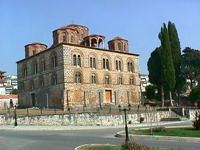
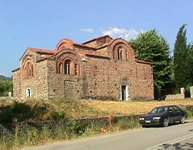
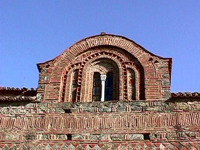
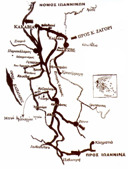
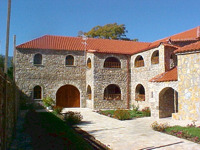
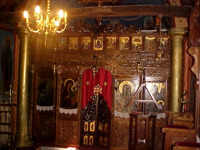
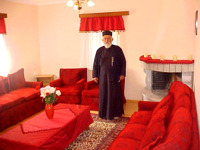
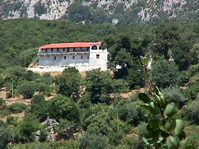
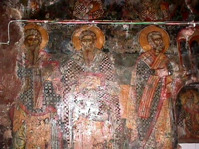
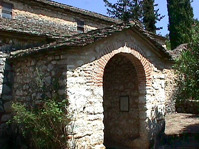
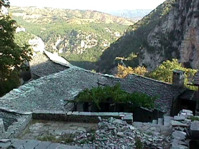
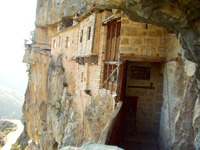
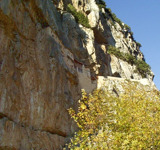
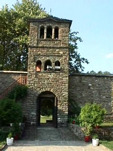
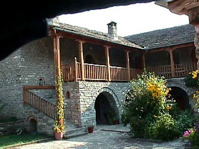
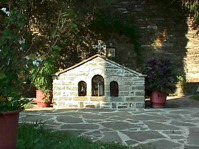 The grave of the Metropolitan Sevastianos
The grave of the Metropolitan Sevastianos